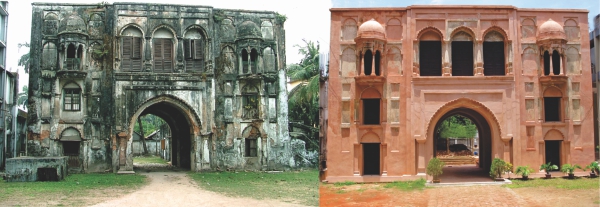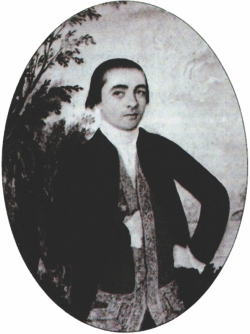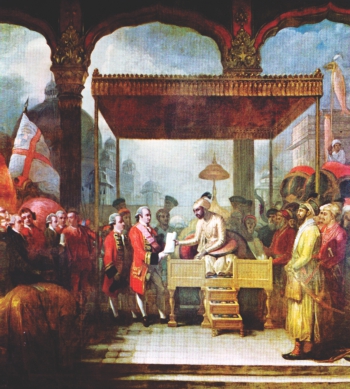| Home - Back Issues - The Team - Contact Us |
 |
| Volume 12 |Issue 03| January 18, 2013 | |
|
|
Heritage The Nimtali Deohri Waqar A Khan
Within the premises of the Asiatic Society of Bangladesh at Nimtali, Dhaka, is located the sole remaining historic Nimtali Deohri (variously spelt as Dewry, Deuri, Deori etc), a multipurpose Gatehouse built in 1766, which once led to an elaborate Palace-complex known as the Nimtali Kothi or popularly, as the Nawab Baree. This semi-octagonal Gatehouse is a fine example of the latter Mughal period architecture. The imposing frontal facade of the Gatehouse is curiously complemented by the rear facade, which is suggestive of an old Haveli. It is the only remaining Gatehouse in the country of its type and period, left almost intact, to have survived the ravages of time and the greed of man. Fortunately for us, the Asiatic Society has most conscientiously completed the painstaking task of restoring this important edifice.
The Nimtali Deohri (Gatehouse) and the now almost non-existent original Nimtali Baradari (Palace) are noteworthy relics of British colonial history in India and that of Bengal in particular. The Battle of Plassey in 1757 saw the defeat of the ill-fated Nawab Nazim of Bengal, Bihar and Orissa, Siraj-ud-Dowlah by the forces of the East India Company under Colonel Robert Clive. But if Plassey was the 'beginning of the end' of the old Indian order, then the end came 'swiftly and decisively' at the Battle of Buxar, Bihar, in 1764, where the combined forces of the nominal Mughal Emperor Shah Alam 11, Nawab Nazim Mir Qasim of Bengal and that of the Nawab Wazir of Awadh (Oudh) Suja-ud-Dowlah were completely routed by the forces of the East India Company under Major Hector Munro. The Battle of Buxar was followed by the Treaty of Allahabad on 12 August, 1765 and the ceremonial handing over of the Dewani (in effect complete control over the territory, revenue and administration) of Bengal, Bihar and Orissa. Thus once the richest former province of the Mughal empire was granted to Robert Clive representing the East India Company by the effete Mughal Emperor Shah Alam 11. This single ceremonial act had profound historical implications of global significance. It transformed the East India Company during its long years of unbridled, pervasive market monopoly in India (1765-1858), into the most successful forerunner of latter day multinational corporations. It would eventually lead to the formation of the last great colonial empire in modern times— the British Raj in India (1858-1947). Immediately following the above mentioned changeover in 1765, the Council at Fort William in Calcutta despatched a distinguished officer Captain Archibald Swinton, fully conversant in Persian and in Indian traditions and customs to Dhaka, to take over the local administration. Swinton skillfully neutralised the remaining authority of the Naib Nazim, took over his old fort (then located inside today's Dhaka Central Jail) as his office-cum-residence, while 'respectfully' moving the Nawab, his family and court to the Bara Kuttra. Swinton was next ordered by the Company to build a permanent Palace-complex befitting the societal prestige and status of the the Naib Nazim, one of the premier nobles of Bengal. He proceeded earnestly to plan and build the Nimtali Kothi but did not see its completion in 1766. He resigned from the services of the Company and left India for good for his home in Scotland in December, 1765. The building of the Nimtali Kothi had strong socio-political implications. Symbolically, it ushered in the colonial rule of the East India Company in Dhaka and East Bengal. It was also the first important secular edifice built by the British colonialists in East Bengal. Successive nominal Naib-Nazims of Dhaka lived in the Nimtali Kothi until the abolition of the position and title by the Company in 1843. The Metropolitan Bishop of Calcutta, Reginald Heber, in his highly interesting accounts of his travels has mentioned in details his meeting in 1824 in Dhaka with the then Naib Nazim at his Nimtali Palace. He described the Nimtali Deohri as a 'handsome gate' and has also left his impressions about the Baradari and the adjoining areas.
The Nimtali Palace property was sold and its valuable possessions auctioned off by the Company in 1843. It subsequently changed hands several times during the intervening period. Following the Partition of Bengal in 1905, a proposal was initiated in 1909 to establish a Museum in Dhaka befitting the newly created province of Eastern Bengal and Assam with Dhaka as its new capital. But nothing came of it until after the annulment of the Partition in 1912. As a sop to the revocation of Partition, the Government of Bengal agreed to set up a museum in Dhaka. Finally, on August 7, 1913, the then Governor of Bengal, Lord Carmichael, inaugurated the museum which was temporarily housed in a room at the present Dhaka Medical College Hospital. In 1915 the museum was transferred to the remnants of the renovated Baradari at Nimtali. The museum office and library was housed in the Nimtali Deohri or Gatehouse. The first curator of the Dhaka museum from 1914 to 1947, was Nalini Kanta Bhattashali an eminent antiquarian — numismatist, epighraphist and iconographist. Since its inception in 1913, the Dhaka Museum Committee was headed by the Commissioner of the Dhaka Division. However, in 1936 the Government of Bengal reorganised the Dhaka Museum Committee, which was then placed under the jurisdiction of the Dhaka University, with the Vice-Chancellor at its head. The Dhaka museum finally moved to its permanent location at Shahbagh in 1983. Today, the Nimtali Baradari which was substantially remodelled in 1969-70, eradicating what remained of its original façade, has been converted into the Ekushey Hall, a residential accommodation for the teachers and students of the Dhaka University. The prestigious Asiatic Society of Bangladesh established in 1952, was housed in the Nimtali Deohri or Gatehouse until it moved to the new adjacent building in 1980. After its recent restoration the Deohri has been transformed into an attractive historic edifice. Flanked on either side by office buildings of the Asiatic Society, it now offers a splendid sight to visitors. It truly lends an 'aura', a certain 'majesty' to the Asiatic Society for which the Society can be justifiably proud! The writer is the founder of Bangladesh Forum for Heritage Studies.
Copyright
(R) thedailystar.net 2013 |


